
searchMenu


The cabaret stage Oberhaus is a cultural highlight of the city centre in Alzey and offers a diverse program for every taste. No matter if it's comedy, cabaret or a live band, the stage offers enough space for every kind of art. Apart from that the visitors can take part in whiskey tastings after their registration or they can prove their skills at a darts competition. Also there are parties in the Oberhaus on a regular basis. The counter is with a length of ten meters one of the longest in Alzey, the musical entertainment is diverse, they…


The town, situated at the foot of the Petersberg, had the rights of a free Reichsstadt in the Middle Ages. From this former importance the large church building, which replaced a previous, similarly constructed building, where relics of the holy bishop Rufus from Metz were worshipped, testifies its former importance. Due to the closure of the vault arches the church has been divided into an evangelical (nave) and catholic part (chancel) since 1705. The two part flat-roofed nave was erected by Johann von Diepach in 1420. Here the north aisle…


With its location directly on the Rhine and in the historical center of Mainz, the Rhineland-Palatinate State Parliament is a special place both politically and architecturally. It is situated in the historic Deutschhaus, an impressive Baroque building from the 18th century, which, after extensive restoration, now combines modern parliamentary work with a historic ambiance. As the seat of the Rhineland-Palatinate state parliament, the Deutschhaus embodies lived democracy and political history. Visitors can get to know the building…

In the village center, a place to stay was set up in a cozy corner, decorated with a modern fountain and an old winepress.

The Museum Schlosspark is a picturesque 18th century castle in a romantic landscape park and presents art and city history collections, as well as exhibitions of contemporary art. The sculptures of the Cauer family of sculptors from Bad Kreuznach are particularly worth seeing. Particularly noteworthy in the museum are the sculptures of the famous sculptor family Cauer from Bad Kreuznach. One of the highlights is the hunting room. The coffered ceiling in this room, the ornamented parquet floors and the wall panelling and built-in furniture…

An extraordinary event location in the vault of a listed winery. You should have seen this place in the geographic heart of Rhinehesse. Cabaret, comedy, readings, classic and jazz concerts and chanson evenings and always a thrilled audience. Who wants to can eat fancy in the castle before the event or can sleep in the hotel room of the old half- timbbered house afterwards.